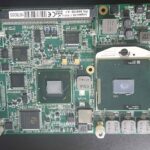The automotive diagnostic landscape is constantly evolving, and with recent updates to Xentry software, the traditional C4 multiplexer is becoming less practical, especially as modern laptops often lack Ethernet ports. This shift has led many automotive professionals to seek alternatives, prompting a transition from LAN-connected C4 devices to USB-connected Vehicle Communication Interfaces (VCIs). While options like WLAN or USB-to-LAN converters exist, they are still fundamentally based on the older C4 technology. For those of us who value stable and reliable connections, especially when dealing with critical tasks like ECU flashing, a wired connection remains the preferred choice. The potential for disruptions during wireless flashing processes due to unstable WLAN is a risk many prefer to avoid.
While it might be technically possible to modify Xentry to continue using C4, it doesn’t appear to be a sustainable long-term solution. This brings us to the question: what are the viable alternatives to the C4 multiplexer? Several options are available in the market today:
- New Mercedes VCI C6: This is essentially the Bosch MTS6532 device, customized with Mercedes firmware and branding.
- Used or Refurbished Mercedes VCI C6: A more budget-friendly option compared to new units.
- Cloned Mercedes VCI C6: A significantly cheaper alternative, often sourced from overseas manufacturers.
- VXDIAG VCI C6 or SE: Devices from VXDIAG offering C6 compatibility.
- J2534 Devices: Universal interfaces like Openport, Scanmatik 2 PRO, or MDI, designed to work with various OEM software.
- Super MB PRO M6: Another multiplexer option available in the market.
While various other multiplexers exist, many are either rebranded C4 clones or have been superseded by VXDIAG or J2534 devices. My specific requirements for a replacement multiplexer were clear: it had to be compatible with XDOS (Xentry Diagnostics Open Shell), operate without the need for extra drivers or software beyond Xentry itself, and be manageable within the Xentry system configurator, specifically using the VCI Manager.
Considering these criteria, the VCI C6 clone emerged as the most appealing option. The genuine Mercedes VCI C6 is prohibitively expensive, often exceeding 3000 euros and difficult to acquire in some regions. Used or refurbished units, while more affordable at around 1600 euros and upwards, still represent a significant investment, often without warranty or return options. The VCI C6 clone, priced around $450, presents a more financially manageable risk, even if returns to China can be challenging.
Alt: A comparison of different Mercedes diagnostic multiplexer options, highlighting the VCI C6 and older C4 devices.
But why dismiss alternatives like VXDIAG, Openport, and other J2534 devices? I previously owned a VXDIAG device, and while not necessarily cheaper, it proved to be less user-friendly. The licensing system of VXDIAG can be problematic, especially when working offline. Forgetting to renew the license in areas with no internet connectivity can create significant operational roadblocks. Furthermore, VXDIAG compatibility with Vediamo, a crucial tool for deeper diagnostics and ECU programming, was always questionable, at least based on my experience.
Openport and similar ultra-low-cost systems, being J2534 devices, are limited to the PassThru version of Xentry. My preference for the full XDOS version of Xentry ruled out J2534 devices entirely. Similarly, MDI or Scanmatik devices were not considered for this primary diagnostic setup. However, I do utilize an Opel MDI clone with GDSII on a separate laptop, connected to the internet and equipped with MBTools. This combination allows for using MBTools on Mercedes vehicles, offering a supplementary diagnostic capability.
The Super MB PRO M6, despite appearing different from the C4, ultimately functions as another C4 clone. While newer versions might incorporate modifications, past negative experiences with a problematic unit discouraged further investigation into this line of devices.
First-hand Experience with the VCI C6 Clone
After several months of using a VCI C6 clone with Xentry OpenShell version 09.2023, the performance is notably superior to the older C4 multiplexer. It demonstrates significantly faster operation and greater stability compared to a standard MUX setup. Unlike the original VCI C6 which includes a separate WLAN USB stick, the clone I acquired did not come with one. Administration is seamlessly handled within the VCI Manager in Xentry, eliminating the need for extra drivers or standalone software installations.
Initially, the Xentry Vci C6 clone was not functional upon arrival. However, the vendor promptly provided updated firmware via TeamViewer, resolving the issue and ensuring stable operation ever since. The package included only essential cables: a 3-meter USB cable and an OBD connection cable. Cables for older 38-pin connectors or Sprinter connections were not included, which isn’t a concern for my current vehicle range. It remains unclear whether adapters or alternative solutions exist for connecting the C6 clone to older vehicles, although the original VCI C6 is purported to support them.
Alt: A close-up of the Xentry VCI C6 clone diagnostic interface device along with the included USB and OBD cables.
Considering that the price of the VCI C6 clone is comparable to that of a C4, and given its enhanced performance and modern connectivity, it stands as a compelling choice for users with similar requirements. Based on my experience, the VCI C6 clone is a recommendable diagnostic interface for Mercedes-Benz vehicles, offering a modern and efficient solution for workshops and automotive professionals. For any further inquiries, feel free to reach out or leave comments below.
